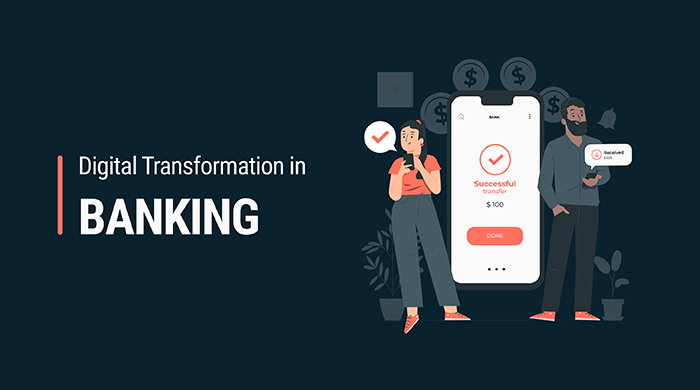A Guide To Digital Transformation In Banking Industry

What is Digital Transformation?
Digital transformation, sometimes called “digitization”, is a vital process in the 21st century. It is typically referred to as utilizing digital technologies or Information Technology (IT) to redesign existing, traditional, analog business operations. These may include logistical, financial, management, and even academic or training operations.
The main purpose of digital transformation process is to meet the needs of the growing market demands and heighten customer experience in the most efficient way possible. Hence, this process completely redefines how value is delivered to customers by optimizing the way a business is operated and managed.
The effects of such digital transformation have become more and more apparent in recent times. Industries such as freight forwarding, academics, and business marketing have already established their transformed services into the mainstream by offering new “Software as a Service” (SaaS-based) solutions such as Enterprise Resource Planning (ERP) software, online learning modules, and product upscaling through e-commerce respectively.
The end goal of the transformation process is to ensure that the industry or enterprise uses technology to continually evolve all facets of its business operation and customer interaction. And a prime example in this regard can be derived from the financial industry – particularly in the banking sector. Here are some strong utilities of digital transformation in the banking industry:
Blockchain Technology
This is the most recent and possibly most controversial digitization initiative taken by members in this sector. It entails setting up a decentralized ledger for payments to facilitate swift and efficient payments. This improves security, enhances efficiency, and streamlines the banking process. It allows for complete autonomy within banking processes and allows customers to engage in more secure transactions with banks in the form of smart contracts.
Blockchain technology also aims to revolutionize intermediary banking operations such as bank-to-bank payments, cross-border payments, processes involving KYC, loans and money lending, and so on. The security aspect of it is aimed at reducing fraudulent activities from personal accounts, such as unauthorized use of credit or debit cards, detection of unusual activities within accounts, and the ability to transparently see transactions between accounts within the public general ledger.
Artificial Intelligence (AI)
Artificial Intelligence development companies help banks to run under proper regulatory compliance. An AI-based digital infrastructure is used widely in fraud detection and indicates suspicious activity, thus enhancing security against hackers. This aspect of digitization aims to work in close collaboration with the aforementioned blockchain technology. Consider, for instance, a transaction between person X and Y. This transaction will be recorded in the decentralized ledger using the encrypted account numbers of both X and Y. Furthermore, when implemented alongside blockchain technology, it will be easier to detect both when the transaction was made as well as at what frequency any transaction was made between the two accounts. Using Machine Learning to teach an AI system to locate these discrepancies can easily weed out fraudulent or uncharacteristic activity to provide reasonable doubt for suspicion, if not red-handed evidence of fraud.
Customer Data Collection, Analysis, and Management
This is a more mainstream utility of digital transformation in banking where powerful insights and analytics derived from computer processes (such as big data) can facilitate customer service. It is possible, and often more beneficial, to incorporate a solid technical framework to help gauge customer preferences, unveil common patterns, and deduce reliability, and so on.
A good use case for this criterion would be the conjunction of Data Science with digital data collection in order to make an informed financial decision. For example, the spending nature of an individual may be discerned from their recent transactions. This information may be extrapolated to determine the trajectory of loan repayment (if one has been issued) or the anticipated return on a loan if one is to be issued.
It is also quite useful to use digital methods to provide financial advice to people based on their spending/investment habits to better facilitate customer satisfaction and to endorse the goodwill of the bank.
Challenges Faced By Existing Technologies
There are a few major challenges that plague the current outlook of the banking sector, each with its own relevance to requiring digital transformation. These are summarised below:
Growing Competition
The dangers presented by FinTechs (financial technology) to traditional banking processes, which generally focus on the most productive areas of financial administrations, are immense. Prior expertise in various realms of manual financial management is easily outclassed by implementing modern technology, as suggested in the above examples.
The new industry sharks who have incorporated a stellar digital framework into their financial sector force numerous smaller organizations to look for partnerships or acquisition opportunities as a backup plan or security measure, just to keep themselves afloat, unless they adapt to FinTechs themselves.
Cultural Obsolescence
It is rapidly becoming a well-known fact that there is no room for manual models and frameworks in the computerized world. Banks and similar financial unions need to proactively consider technologically forward goals to resolve challenges in the financial industry. This is in no way unachievable or unrealistic; moreover, it is a necessity to avoid obsolescence. In fact, it is the big players in the realm of finance that endorse a culture of development and evolution in which technology is used to improve existing processes and to provide strategies to achieve the best results.
This game-changing social shift toward a more culturally adaptive business framework is the minimum requirement to compete in today’s financial climate, and is indicative of a larger, mutually agreed upon change for a digital future.
Growing Expectations
The present buyer (particularly a millennial) is more intelligent, savvy, and educated than any generation before. The current climate of expectations from any sector, particularly finance, is of a targeted personalization and organic comfort out of banking experiences.
Easily influenced clients and indirect marketing to more informed demographics play a significant role in these expectations: each new decade of banking client comes with more specifications, an innate and detailed comprehension of technology, and, as a result, a greater expectation from their banking experiences.
Client Retention
In continuation of the previous point, financial service clients rely on anticipating customized, basic, and instinctive interfaces on smart devices to derive meaningful experiences from their endeavors. This may be something as meager as running a Google search through speech, or as convoluted as sending a personalized gift to a loved one through e-commerce websites.
The faithfulness of a client is rapidly turning into a point of reference that influences prospective clients, which is in turn dependent on their overall satisfaction in order to be retained. The loyalty of any client is heavily reliant on rich customer relationships built by deeply understanding the client and their expectations from the firm.
Why Is Digital Transformation A Necessity In The Banking Industry
Now that it is clear how large of an impact digital transformation is to have on the future of finance as a whole, it is important to also recognize what utility corporations will derive from this change in the long run. Each digital transformation drive will have its own distinct motivations pertaining to any of the challenges discussed above, or even more that are specific to their mode of operation. Generally speaking, however, the prime reason behind any transformation initiative is to improve a firm’s existing operations and processes for better returns on investment (ROI).
Digital transformation is significant to the banking industry in this way because it helps banks and associated firms grow and evolve to stay relevant in their industry. If a business refuses to capitalize on the revolution and develop, they stand no chance of competing with the current market sentiment, let alone adapt to future changes.
However, mistakes are commonly made in attempting large systemic changes such as this. Incorporating a whole new framework into a business that has been running lucratively for generations will definitely come across setbacks if manipulated carelessly.
For instance, various banks commit to this process of digitization erroneously by taking on a series of independent and incoherent digitization initiatives. These struggle to succeed financially because they do not have the lasting dedication or coordination to contend with long-term employers of similar solutions.
All things considered, digital transformation in banking should involve a systematic approach when it comes to implementation. Understanding the requirements of clients, the use of computerized frameworks, the application of related software, and how it all comes together in infrastructure is paramount in order to achieve the best results from this vital change.
Where To Get Started With Digital Transformation
Digital transformation requirements will vary extensively depending on the goals of a business (both immediate and long-term) and its consequence to their target audience, current digital climate, existing business model (and possible room for consistency), and predicted trajectory of their market. To this end, the most imperative stages of digital bank transformation can be summarised as follows:
- Become proficient with data and analytics, and learn to use them to your advantage.
- Decide where to and enhance the consumer experience and what aspects of your brand to keep unique.
- Follow-up with peers and employees, and encourage innovation within the organization.
- Find places to use existing technologies to your advantage and reinforce the rest with modern innovations.
- Implement these changes into regular operations.
- Adjust and re-skill your employees to suit the novel changes.
- Re-align the company’s short and long-term goals with improved, digital prospects.
Conclusion
Bank digital transformation is not as easy as it sounds; and it sounds quite convoluted to begin with, as evident from the large sum of banks presently coming up short at their own transformative endeavors. With reasons ranging from a lack of conviction to a particular objective to an obvious lack of support in implementing new digital horizons, banks will need to make this change towards digitalization by evolving their approach towards the current market, replacing obsolete frameworks, and attempting to make peace with the new era of informed clients.
This will help develop a wide variety of single-use digital features and eventually lead to the access of a completely digital framework. When the digital transformation is accomplished, banks and the industry as a whole can offer more prominent worth to buyers, particularly when upheld via troupes of transparent, smart technologies.
Blogs by Category
AppForms Artificial Intelligence Blockchain Call Centers Chatbots Cloud Computing Data Management Design Digital Marketing Digital Transformation Enterprise Applications FinTech Insights LowCode Development Microsoft Mobile Apps News Office 365 Robotic Process Automation Security SharePoint Software Development Web ApplicationArtificial Intelligence in Fintech

2024-05-23 19:09:40